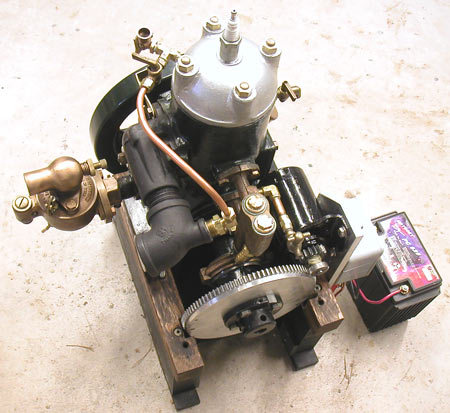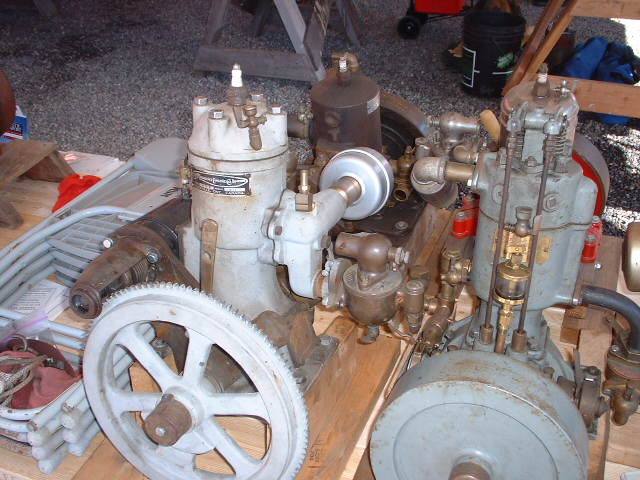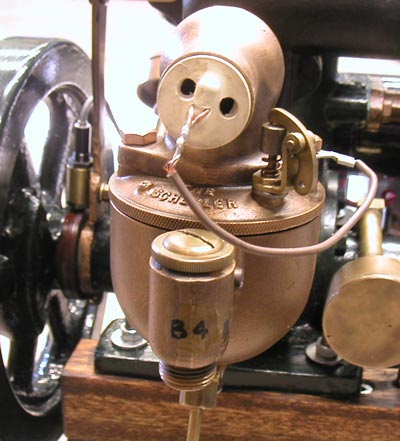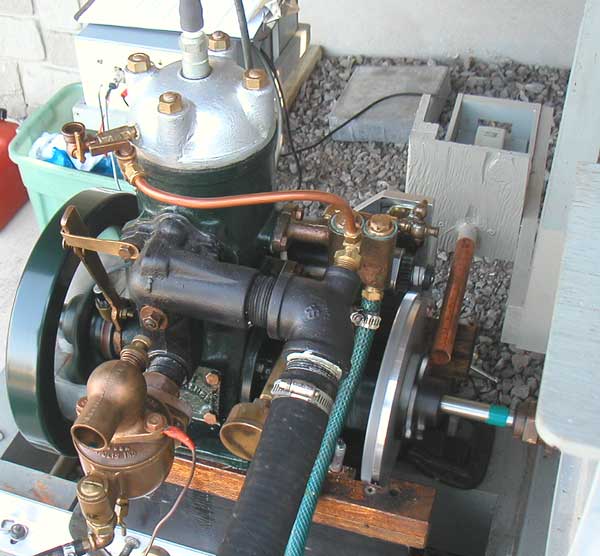|
| Electric start for 2 cycle engine |
| Author |
Message |
    
barry
Senior Member
Username: barry
Post Number: 51
Registered: 02-2006
| | Posted on Monday, November 19, 2007 - 03:57 pm: | 




|
I regularly use a single cylinder St Lawrence 3 port, 2 cycle engine to power my dory. As is typical, I hand start the engine, then crawl over the bridge deck to the steering station. Although my Kitchen rudder makes it possible to start the engine at neutral setting, the climbing in and out and back and forth is becoming more difficult due to age related physical limitations.
So I built an electric starter using readily available Briggs and Stratton 12V motor and ring gear as illustrated by the image. This works better than expected, the engine starts after a two second crank without priming or choking. I have bench tested the setup and will install it next boating season on my boat engine that is identical to the test engine. Using a small AGM battery (27 amp reserve capacity), I reached 125 cranks on a single charge so thankfully on board charging is not required.
One observation puzzles me. I thought to provide details here and ask others who use 2 cycle engines to help me help me understand what to me is a paradox.
Note the copper tubing and quarter turn hand valve installed from the priming cup to exhaust elbow. This to relieve compression to reduce starter motor torque (and current draw). This does the job. As expected the small motor will not turn the engine over TDC unless the compression relief valve is open. Of course the engine will not fire with the valve open.
The starting procedure is to push and hold the start button then immediately close the compression relief valve, the engine starts without hesitation.
Here is the paradox. I was playing with the system without ignition or fuel supply connected, just as illustrated by the image. I connected an IR tachometer and energized the starter with compression relief valve closed. Engine would not turn over. I opened the valve, engine cranked at about 240 RPM.
I closed the valve during cranking expecting the engine to stall. The opposite occurred. Engine RPM increased to about 350 RPM.
Any thoughts ??
Barry
 |
    
jb_castagnos
Senior Member
Username: jb_castagnos
Post Number: 316
Registered: 07-2002

| | Posted on Monday, November 19, 2007 - 10:10 pm: | 




|
Nice installation on the starter Barry, should make life a lot easier for you. I don't think our boats have enough clearance in the rear for this setup. On the compression release, it should be where the petcock is on the other side, kills about half the stroke, but should still run. If it's to be tapped in at the top like you have it it should go into an expansion chamber where the air is compressed and returned, like a spring. The increased volume will decrease compression ratio but allow it to run once it fires. On the variable displacement engines being offered on the new trucks, and previously by Cadillac, the valves are both kept shut, the air in the cylinder acts as a spring and it takes very little power to keep it turning. If the valves were allowed to operate and fuel was shut off, it would have to keep pumping air, consuming a lot of energy. I think that's what's happening with your release open. |
    
ernie
Senior Member
Username: ernie
Post Number: 763
Registered: 01-2002

| | Posted on Tuesday, November 20, 2007 - 08:14 am: | 




|
Here is the St Lawrence flavor. Have you ever seen one up there in St Lawrence Country?
 |
    
ernie
Senior Member
Username: ernie
Post Number: 764
Registered: 01-2002

| | Posted on Tuesday, November 20, 2007 - 01:18 pm: | 




|
Barry,
Also if the throttle is closed the engine will not be getting much air to compress. Unlike the first revolutoin where the engine was full of air. Lots of compression as in it couldn't turn the engine through TDC.
More food for thought
Ernie |
    
barry
Senior Member
Username: barry
Post Number: 52
Registered: 02-2006
| | Posted on Tuesday, November 20, 2007 - 06:52 pm: | 




|
JB & Ernie,
Much appreciate your interest in this subject. Thanks for your replies.
St Lawrence model XAE as shown in Ernie’s post use a ring gear and starter motor same as were used on Ford Engines. Apparently the ring gear is still available today. The ring gear is shrunk onto the flywheel of an XA engine and the starter motor attached using a custom bracket. XAE engines were used to power Dispros in the 1940s. At least 50 of these engines are regularly used today to power restored Dispros. The starter motors were originally for 6 volts. Many are now used with 12 volts. These have huge torque so decompression is not required.
Incidentally at least 200 Dispros have been restored and are actively used, many in the Muskoka area north of Toronto, Canada, all powered by old marine engines, most 2 stroke, some 4 stroke.
I considered modifying my engine using the XAE motor and ring gear, but do not wish to give up the hand start option as I find hand starting provides great interest. Hand starting requires one to understand the fine points of 2 cycle engine operation …such as the subject of this post.
I would not wish to hand start a XAE by gripping the ring gear !!
JB, I believe your reference to the technology of variable displacement engines as the path to understanding the apparent paradox described in my original post is very perceptive. As I understand this technology, a cylinder in a four cycle engine is deactivated by keeping the inlet and exhaust valves closed thus creating an air spring in the combustion chamber. The trapped exhaust gases are compressed during piston upstroke then expand to power the piston during downstroke.
One force balances the other so there is little engine power required for the deactivated cylinder. If the valves were allowed to operate normally and only fuel cut off, then the cylinder would function as a pump with a lot of engine power required, hence the term “pumping losses”.
I believe this may help to explain the seemingly strange action of my two cycle engine although two stroke operation can not be as straight forward… no valves to shut off.
1 The tiny starter motor does not have sufficient torque to start to crank the engine to compress gases on top of the piston, pull a vacuum then compress gases in the crankcase and start the various engine parts in motion.
2 When the decompression valve is open, this eliminates the largest energy need … to compress gases on top of the piston; the starter motor then has adequate torque to crank the engine at about 240 RPM. However downward movement of the piston must still compress gases in the crankcase and upward movement must still pull a vacuum both requiring power. The engine then acts as a pump to move gases to exhaust.
3 When the decompression valve is then closed, the energy contained in the rotating flywheel adds to the starter motor power to compress gases on top of the piston, and then these compressed gases can help power the downward stroke. Thus less power is required from the starter motor so motor RPM increases….. to about 350RPM.
As I read this I’m unsure whether this confuses or enlightens.
I used my digital camera to record two videos pertaining to this subject. They may provide more food for thought. File size is 2.5mb the other 4.5mb, both “mov” format. I’ll email these to anyone interested in this subject as file size is too large to post. High speed internet is a must.
Barry |
    
andrew
Moderator
Username: andrew
Post Number: 893
Registered: 11-2001

| | Posted on Tuesday, November 20, 2007 - 07:00 pm: | 




|
Barry,
If you want to email the video files to me I could post them on my this server and provide a link from here. You could also post them on youtube.com and then link from here to the video on youtube.com |
    
andrew
Moderator
Username: andrew
Post Number: 894
Registered: 11-2001

| | Posted on Wednesday, November 21, 2007 - 07:50 pm: | 




|
Barry sent me the video and I have uploaded them to the server. You will need to have Quicktime or some other video viewer installed on your computer. They will open in a new window.
PICT0002-1
quote:This shows electric starting procedure.
Compression relief valve connected at top of combustion chamber is open
Ignition is on and retarded
Schebler is adjusted for normal operation, not rich setting
No choke or priming used
Start button is pushed, compression relief valve immediately closed, RMP increases and engine starts
Note: air temperature is about 7C (45F)
*************
PICT0002
quote:This illustrates engine RPM increase when compression relief valve is closed during cranking and RPM decrease when valve is opened.
|
    
barry
Senior Member
Username: barry
Post Number: 58
Registered: 02-2006
| | Posted on Thursday, December 06, 2007 - 08:06 pm: | 




|
Did anyone view PICT 0002 .. any thoughts?
Barry |
    
jb_castagnos
Senior Member
Username: jb_castagnos
Post Number: 322
Registered: 07-2002

| | Posted on Thursday, December 06, 2007 - 09:57 pm: | 




|
Barry, it's about what I expected. The compression release on 60's model Evinrudes was a dome with a valve, when you cranked the engine a lever from the hand crank pulley would wind out and open the valves, allowing compression to go into the dome, where it was returned. I remember outboards with a blown head gasket being hard to crank with the starter, much like your engine with the release open. A friend had a dirt bike in the 70's, two cycle with a compression release. The compression release was used for braking, it had a check valve to allow air to exit but not go back in. Hitting the release would slow you down as fast as the brakes. |
    
jb_castagnos
Senior Member
Username: jb_castagnos
Post Number: 323
Registered: 07-2002

| | Posted on Thursday, December 06, 2007 - 10:01 pm: | 




|
Try venting the compression into a cappped section of 1/2" pipe, maybe 6" to start. This will reduce the compression ratio, but allow the spring action to remain. |
    
barry
Senior Member
Username: barry
Post Number: 59
Registered: 02-2006
| | Posted on Friday, December 07, 2007 - 09:56 am: | 




|
JB,
Am not sure we are "singing from the same song book". You refer to an engine that is operating with fuel and ignition connected, not being cranked only by the starter motor.
The compression relief that is illustrated in the images and video clips works great, look at PICT 0002-1.
The situation illustrated in PICT 0001 is without fuel or ignition connected; the engine is powered only by the small starter motor.
With the compression relief valve open, the starter motor cranks the engine without difficulty.
It's when I close the relief valve as shown in PICT 0001 that I expected the engine to stall, but the opposite happened, crank speed increased.
This is only a point of interest, I am satisfied that the electric starter will be successful when I install it next Spring on my identical St Lawrence that powers my dory.
Barry |
    
ernie
Senior Member
Username: ernie
Post Number: 774
Registered: 01-2002

| | Posted on Friday, December 07, 2007 - 09:02 pm: | 




|
Barry,
From above (unless I missed it)
what is the throttle position when you close the compression realease?
If the throttle is closed the engine will not be getting much air to compress. Unlike the first revolutoin where the engine was full of air. Lots of compression as in it couldn't turn the engine through TDC.
More food for thought?
|
    
barry
Senior Member
Username: barry
Post Number: 60
Registered: 02-2006
| | Posted on Saturday, December 08, 2007 - 11:11 am: | 




|
Ernie,
I ran several tests this morning with the Schebler throttle plate fully open, also closed to the slow speed setting, also at half position.
The action is the same, regardless of throttle position, crank speed increases when the relief valve is closed as illustrated by PICT 0001.
This unexpected action where the crank speed increases when the relief valve is closed during cranking is hugely beneficial as it occurs at the exact time that the engine fires.
Had the engine slowed down during cranking, as I expected to happen then it may have stalled before firing, thus using this small starting motor would not be satisfactory.
Following up on JB’s remarks, the starter motor does not produce sufficient torque to crank the engine using the side mounted decompression petcock and I doubt that it would crank against a closed chamber.
Anyway, the unexpected crank speed increase facilitates and ideal starting procedure.
Open the compression relief valve, turn on ignition, crank the engine, close the relief valve, crank speed increases, engine fires.
I doubt that it will be necessary to enrich the mixture or prime, as a lot of heat will occur from multi compression strokes during cranking (about 15 strokes during a 3 second crank), probably enough to vaporize the last fuel charger that enters the combustion chamber before ignition.
However if it is necessary to introduce a rich mixture, I will use a “sink stopper choke” as illustrated by the attached image. This is made from a 1” diameter rubber sink stopper with two ¼” drilled holes. I have been using this with great success for hand starting. I insert the stopper, pull the engine over TDC twice, to charge the combustion chamber and crankcase, turn on ignition, pull once more and the engine starts. I then remove the choke, plug as the mixture is too rich to continue firing and then use my thumb over the air horn instead of the plug for a few seconds until engine runs without hesitation.
This eliminates priming and Shebler needle adjustment. I find it more convenient than the butterfly choke that was supplied with some Scheblers.
Barry
 |
    
barry
Senior Member
Username: barry
Post Number: 61
Registered: 02-2006
| | Posted on Saturday, January 12, 2008 - 01:13 pm: | 




|
JB,
The information that you posted is absolutely correct and provides the basis for this post. At the time of your November posts, I wasn’t able to fit your explanation into my thought process.
I have since pondered this. Last night a 3.00 AM I awoke with a clear mind picture. I therefore hasten to record this detailed explanation as I believe understanding of this starter issue provides incite into a better understanding of engine operation.
**************************************************
When piston is moving up during cranking with compression relief open, air is forced out through a very small hole. Because the hole is small, a back pressure occurs during upward stroke.
When piston is moving down, air is pulled in through the same very small hole. Because the hole is small, air does not enter in sufficient quantity to avoid pulling a small vacuum.
Thus cranking motor must supply energy to push air out of the small relief hole during up stroke and suck air in through the same hole during down stroke. This limits cranking speed to 240 RPM. This is the pumping loss, referred to in your Nov 19 post.
When relief valve is closed there is greater resistance to upward piston movement because air above the piston must be fully compressed. Energy to power this compression is supplied by the cranking motor and supplemented by energy drawn from rotating flywheel. The cranking motor alone cannot provide enough power. This is evident when attempting to start cranking with relief closed; starter motor power is insufficient and flywheel energy is not available so the first crank does not occur.
Now when piston downward movement begins, the compressed air on top of the piston is available to assist cranking motor so piston speed increases and energy is added to the rotating flywheel to be used during next upward stroke.
This is a spring action and is the principal of variable displacement described in your Nov 19 post.
The pumping loss is not present when relief valve is closed so cranking speed increases to 340 RPM.
Here is a useful link
http://en.wikipedia.org/wiki/Cylinder_deactivation
I conducted another test to validate and add to this explanation.
Spark plug was removed to provide much greater relief during cranking. As expected, cranking speed increased to 440 RPM as there was no resistance other than moving part friction. This suggests that the spring action describe above is not totally balanced but it doesn’t matter as the speed increase from 240 RPM to 340 RPM is ideal as an even greater heat of compression is available to cause fuel vaporization and positive starting.
This also leads me to believe that a small starter motor can be used with a much larger engine than my St Lawrence XA, even your XD providing the relief passage is drilled out to a larger size.
The next activity will be to operate the starter against propeller load, hopefully in April when the weather allows test bench operation.
Again, many thanks for the supplying the information that provided a path to this understanding.
Barry |
    
barry
Senior Member
Username: barry
Post Number: 64
Registered: 02-2006
| | Posted on Saturday, April 19, 2008 - 07:36 pm: | 




|
Now that spring is here, I’ve tested the electric starter using my test bench to be sure the tiny starter motor will crank against propeller load.
http://www.oldmarineengine.com/discus/messages/5/95722.html#POST15610
I’ve since replaced the used motor with a new one from Jacks Small Engines ($50.00) as the bearings in the used motor were very stiff. Now with the compression relief open, then closed, engine cranks at 450 RPM.
Engine starting is almost instant, about 2 seconds… priming is history.
Here is the starting procedure when engine is cold. I insert the “sink stopper choke”, (refer to the Dec 08, 2007 post in this thread), retard ignition timing, open the compression relief valve, turn on ignition, and then crank the engine. I then close the compression relief valve and engine instantly starts, I then pull the sink stopper choke and advance ignition.
If engine is warm then the sink stopper choke is not needed.
I believe the high crank speed, vaporizes mixture during multiple compression strokes after compression relief valve is closed.
Barry
 |
|
|
|


|


